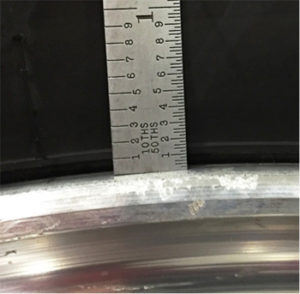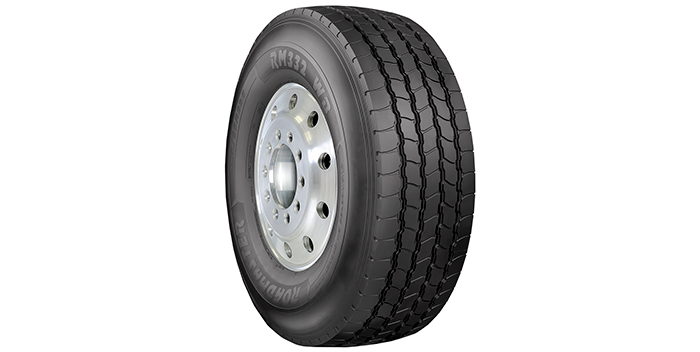When asked by Fleet Equipment what maintenance practices they would recommend to preserve tire casing integrity, Cooper Tire and Rubber Co. provided an extremely detailed answer, which, while unable to make it into the print story, we thought we would share here so fleets can bolster their knowledge. Here is the full answer from Gary Schroeder, director of commercial vehicle and global OEM sales for Cooper Tire and Rubber Co., assigned to the Roadmaster brand:
“Preserving tire casing integrity should be an integral part of an overall tire maintenance strategy. There are a number of factors to consider in order to make the correct tire choice for your needs,  including vehicle usage and tire performance characteristics such as fuel economy, durability, traction, miles to removal, safety and price—as well as casing retreadability. At Roadmaster, we believe in order to get the most out of your tires, it’s important to find a brand that will provide long miles to removal, as well as one that takes into account the casing quality and belt package. The casing quality will tell you a great deal about the tire – how it will hold up and the value the tire has for its second and third life in retreading. When choosing a new tire, part of the consideration should be a review of the tire manufacturer’s warranty and casing allowance. All Roadmaster tires are engineered for retreadability and are backed with a strong warranty of two retreads within six years.
including vehicle usage and tire performance characteristics such as fuel economy, durability, traction, miles to removal, safety and price—as well as casing retreadability. At Roadmaster, we believe in order to get the most out of your tires, it’s important to find a brand that will provide long miles to removal, as well as one that takes into account the casing quality and belt package. The casing quality will tell you a great deal about the tire – how it will hold up and the value the tire has for its second and third life in retreading. When choosing a new tire, part of the consideration should be a review of the tire manufacturer’s warranty and casing allowance. All Roadmaster tires are engineered for retreadability and are backed with a strong warranty of two retreads within six years.
“In order to get the most out of your tires—and preserve casing integrity—tire maintenance is crucial. Tires and wheels/rims should be thoroughly inspected on a regular basis, before each trip and daily during continuous service, with special attention to inflation pressure. Maintaining proper inflation pressure in tires is the single most important factor in extending tire life. Over and underinflation have negative effects on the tire by changing its footprint, which is the area contacting the road. Underinflation can cause excessive heat buildup and can potentially cause internal structural damage. Overinflation can make tires more vulnerable to cutting, punctures or breaks from sudden impacts. When the tire is not contacting the road as the tread design intended, the tread area will also wear irregularly and cause rapid wear on the tread surface. Correct inflation pressure is determined by the load carried for each tire.
“Also, it’s important to determine the proper tire for the service application. Make sure that the tire matches your service type. A tire designed for long haul trucks will not necessarily perform well in a mixed service application. Many tires that are used in both paved highway with some gravel roads, or even off-road use, require a different tread design and more cut/chip resistant tread to give good service. Tread designs that resist stone retention are also an advantage in avoiding stone drilling and casing damage. Make sure that the tire load capacity matches the axle weight on your trucks. Mud traction or snow traction may be needed, and this will definitely influence the tread design as well.
“Since tires are often the biggest operating expense after fuel, a lot of money is riding on a vehicle’s wheels. After all, a typical tractor/trailer runs 18 wheel positions. The owner’s investment in tires is worth protecting, and it’s worth knowing how to maximize performance based on operational factors. Taking into account overall tire performance for the application, including miles to removal and retreadability, there’s a lot to consider. Many times, certain factors can, and should, be monitored on a daily basis. Let’s talk about a few of them:
1. Maintain Proper Tire Inflation: The number one tip for long tire life is maintaining proper inflation. The key to a good tread footprint (the area of the tire in contact with the road) and even tread wear is maintaining proper inflation. Both over- and underinflation have a negative impact on the tire’s footprint and tread wear. When the tire is not contacting the road as the tire design intended, the tread area will wear irregularly, and therefore, more rapidly. Underinflation causes excessive heat build-up and potential internal structural damage, whereas overinflation makes it more likely for tires to be cut, punctured or damaged by sudden impact. In order to determine the proper tire inflation needed, take into account actual weight by axle and use a load/inflation table. Mismatched tire inflation on dual assemblies is typically an important contributor to faster tire wear. For example, in an 11R22.5 tire size mounted in a dual assembly with the same tread design, you would assume that both tires are the same size with the same circumference. At a 5 PSI difference in inflation, the tire with the lower inflation has a circumference that is 5/16-in. smaller. During every rotation cycle, the smaller-circumference tire will scuff ahead to keep up with the tire that has higher inflation. To make this point clearly: tires rotate approximately 500 times per mile. Simple math: 500 times 5/16-in. equals 156.3-in. per mile, or 13 feet per mile. Imagine dragging a tire 13 feet every mile! How many feet is that per day or per year? That illustrates clearly why you will see more rapid tire wear with improper tire pressure.
As noted, a load/inflation chart is a great tool to utilize—it will pay dividends. With an 80,000-lb. gross vehicle weight, the load/inflation is relatively easy. The typical steer axle load is at 12,000 lbs., or 6,000 pounds per tire. In a 295/75R22.5 tire, 110 PSI cold gets you to 6,175 lbs. load capacity for each tire. On the duals at 17,000 lbs. per axle, or 4,250 lbs. per tire with the same size 295/75R22.5 tire, the inflation figure at 85 PSI carries 4,690 lbs. per tire. This is not the old ‘100 PSI works for all’ scenario. You get better wear, longer tire life, and fewer impact breaks at this lower inflation figure.
One more thing to consider: even if you are using an automatic inflation system, you still need to check your inflation pressure on a regular basis. Don’t assume the tire inflation is perfect, especially if you have mismatched dual assemblies. Roadmaster recommends checking tire condition and pressure on a weekly basis, before each trip and daily during continuous service.
2. Routine Tire Rotations: The second tip to longer tire life is to routinely rotate the tires—especially in areas of irregular tread wear. Tire rotation can often improve tire wear. Why is this? When there is a change in the direction of the rotation, or when cross-rotating the tires, some irregular wear can be improved. Roadmaster recommends rotating tires when they are 50% worn, or even earlier if they show signs of irregular wear. Changing the direction of rotation also has a tendency to even out heel/toe wear on the shoulders of drive tires and erratic wear on the shoulders of trailer tires. Steer tires are normally rotated side-to-side, which again changes the direction of rotation and helps even out wear. At a 3/32-in. to 4/32-in. difference in tread depth between the drive axle tires, a cross-rotation would be recommended to even out the wear and increase tire life before removal. Directional tires are the only tires that should not change the direction of rotation. Drivers of trucks with dual drive axles perform a tire rotation if the wear gets to 3/32-in. to 4/32-in. difference from axle to axle. If irregular wear is noticed, a cause must be determined and the situation resolved.
3. Check for Irregular Wear: While rotating tires can help even out irregular wear, you still need to investigate what is causing the issue. Irregular wear conditions will lead to premature tire removals. When tires are not wearing evenly, fuel economy will drop. Eventually, irregular wear reduces mileage and increases your costs, since you will need to replace your tires more frequently. Irregular wear also causes vibration and ride disturbances.
There are many reasons commercial truck tires may develop irregular wear, including:
- Improperly seated bearings
- Inflation pressure issues
- Alignment problems
- Overloading
- Suspension system issues
- Hub and drum non-uniformity or run out
- Antilock braking system malfunctions
- Wheel conditions
- Imbalance
- Improper installation
The best source for information on tire wear, including photos and causes of different types of irregular wear, is the American Trucking Associations’ Technology and Maintenance Council (TMC) Radial Tire Conditions Guide. In the guide, wear conditions are analyzed by steer, drive, and trailer positions.














